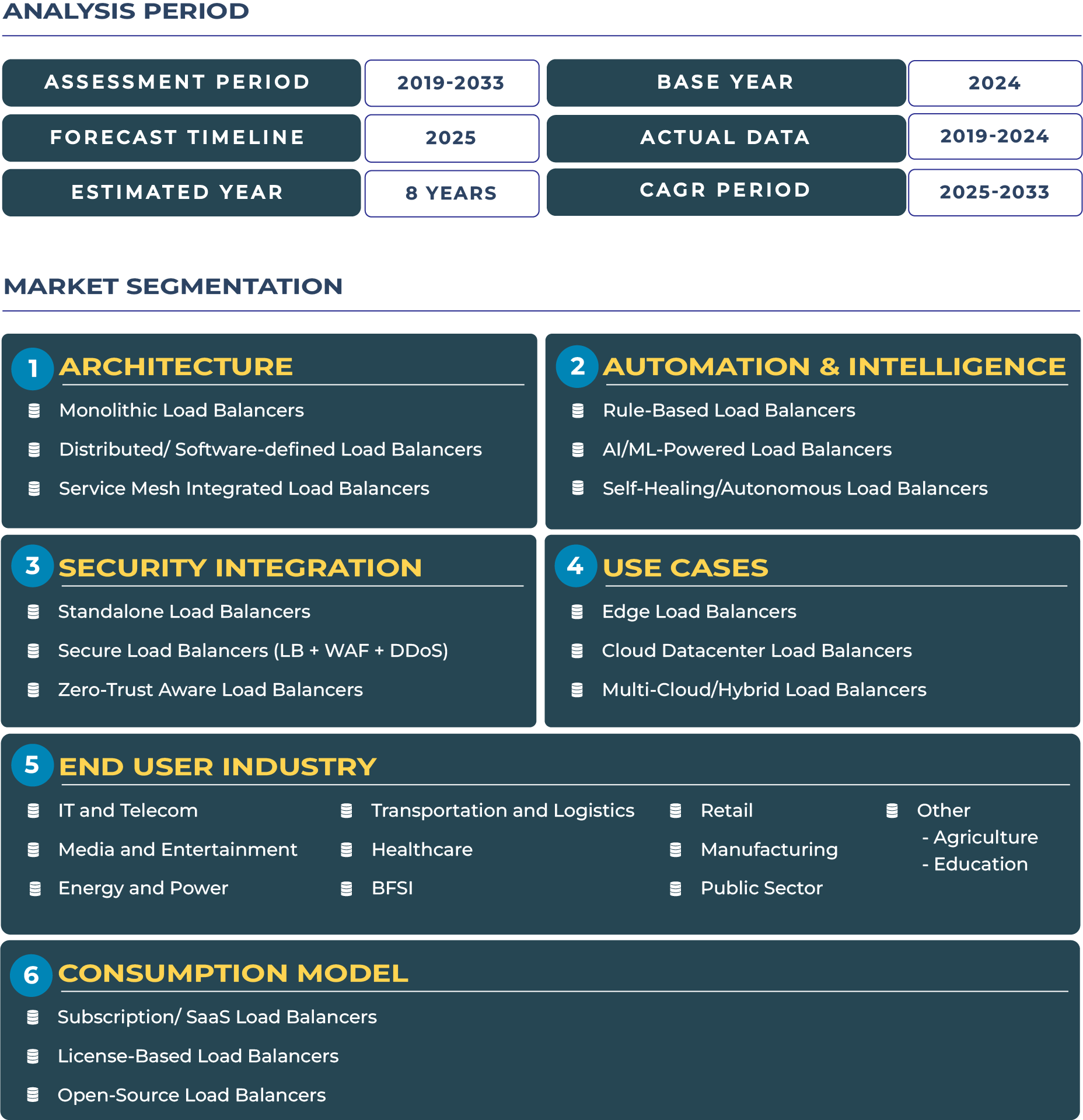Report Format:
![]()
![]() |
Pages: 110+
|
Pages: 110+
Oman’s Gradual but State-Supported Path Toward Cloud Load Balancer Adoption
Oman’s digital economy is advancing through a steady, state-supported path, where telecom operators and government initiatives are steering enterprises toward cloud-native ecosystems. Under the leadership of Oman’s Information Technology Authority, policies are driving modernization across public services, while major telecoms such as Omantel play a central role in extending cloud capabilities across the Sultanate. Within this evolving landscape, the demand for cloud load balancers is becoming increasingly vital. These technologies ensure secure, reliable, and scalable traffic management across diverse applications—from e-government portals to enterprise SaaS workloads. The Oman Cloud Load Balancers Market is projected to reach USD 13.4 million in 2025 and grow to USD 43.1 million by 2033, expanding at a CAGR of 15.7% during 2025–2033. This growth is underpinned by public-sector modernization, strategic telecom partnerships, and increasing adoption among SMEs seeking managed digital infrastructure at lower costs.
Oman Cloud Load Balancers Market Outlook: A Telecom and Government Anchored Cloud Load Balancer Landscape
The market outlook for Oman cloud load balancers industry reflects the country’s unique combination of telecom-led investments and state-backed digital policies. Unlike larger GCC economies where hyperscalers dominate, Oman is gradually shaping its digital foundation by embedding load balancing solutions into telco-hosted cloud services and government-driven digital platforms. With modernization programs tied to Oman Vision 2040, the government is increasingly relying on secure and high-availability application delivery frameworks to power public administration, healthcare records, and education portals. This is strengthening demand for distributed and software-defined load balancers that can ensure resilience and compliance across mission-critical workloads.
SMEs are another key driver of demand. With the government offering incentives for digital transformation, small businesses are adopting simplified, service mesh-integrated load balancer solutions that align with their limited budgets but offer enterprise-grade reliability. While procurement cycles are slower compared to regional neighbors, the steady rise of digital-first initiatives across Muscat, Sohar, and Salalah highlights the progressive nature of the sector. Overall, Oman’s market outlook suggests a strong, steady curve—neither explosive nor stagnant—anchored by structured state support and telco-distributed infrastructures that provide enterprises and public bodies alike with scalable, sovereign-lite architectures.
Key Drivers and Hindrances Shaping Oman’s Cloud Load Balancers Market
One of the strongest market drivers is the public-sector modernization push. With initiatives like e-government digitization and smart public utilities, Oman is increasingly investing in high-availability cloud infrastructures where load balancers serve as critical enablers of uninterrupted services. Another driver is the telecom sector’s core upgrades, with Omantel and Ooredoo introducing cloud-hosted service portfolios that include resilient load balancing functions as part of managed packages for enterprises. Complementing these developments are strategic cloud policies aimed at aligning the country with regional digital competitiveness, ensuring a steady rise in demand for distributed and service-mesh integrated load balancer solutions.
On the other hand, several restraints affect the pace of growth. The relatively smaller enterprise base compared to larger Gulf markets means that cloud load balancers adoption is concentrated among a narrower set of industries, primarily government, telecom, and select private enterprises. Budget constraints in both public and private sectors limit the ability of organizations to procure premium-grade load balancing architectures. Moreover, longer procurement cycles, often tied to centralized decision-making and regulatory approvals, slow down technology rollouts. These factors collectively create a market where adoption is gradual but consistent, reflecting Oman’s pragmatic approach to digital transformation.
Emerging Trends and Opportunities in Oman’s Cloud Load Balancers Ecosystem
One of the notable trends shaping Oman cloud load balancers landscape is the growth of telco-hosted cloud services. By embedding load balancer capabilities directly within their service offerings, telecom operators are lowering barriers for enterprises that lack in-house expertise. Another trend is the government’s steady embrace of cloud adoption, with state projects increasingly relying on sovereign-lite cloud models where application delivery resilience is a non-negotiable requirement. Additionally, managed services for SMBs are becoming more prevalent, as smaller enterprises outsource their cloud balancing needs to telcos and local service providers.
Opportunities in Oman’s market are expanding alongside these trends. Telco co-sell load balancing offerings create bundled services where enterprises gain both connectivity and cloud balancing solutions under a single contract. The development of public-sector sovereign-lite load balancers allows the government to build compliant yet flexible infrastructures. Furthermore, simple SMB-focused load balancer SaaS models are emerging as a lucrative opportunity, where vendors can provide cost-effective, pay-as-you-go services tailored to small businesses that are beginning their digital transformation journey.
Competitive Dynamics: Telecom Partnerships and Public Sector Anchors Leading Market Evolution
The competitive landscape of Oman cloud load balancers sector is defined by a strong interplay between international vendors and domestic telecom providers. Global companies such as F5 Networks continue to offer premium-grade solutions, while local telecom operators like Omantel are packaging distributed load balancing features into their managed cloud portfolios. Partnerships between telcos and global technology vendors are enabling cost-effective, scalable rollouts tailored for Oman cloud load balancers market size. Recent announcements in 2025 about Omantel expanding its cloud services portfolio highlight the growing emphasis on sovereign-ready architectures where load balancers ensure compliance and traffic optimization.
Strategies shaping the market include telco partnerships with public sector agencies, ensuring that early demand anchors from government projects support long-term market growth. Vendors are increasingly differentiating themselves through simplified, compliance-assured offerings for SMEs and public services. While the competitive intensity remains moderate compared to larger GCC peers, the focus on reliability, integration with local telecoms, and alignment with state policies is defining Oman’s cloud load balancers landscape in 2024 and beyond.







